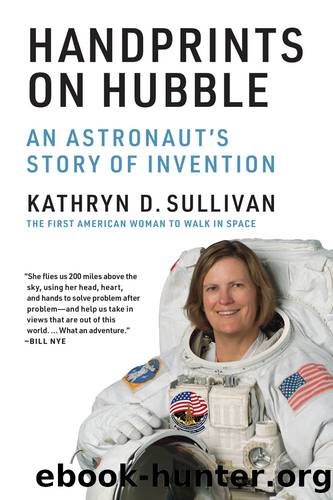Handprints on Hubble by Kathryn D. Sullivan

Author:Kathryn D. Sullivan [Sullivan, Kathryn D.]
Language: eng
Format: epub
Publisher: MIT Press
Figure 6.2
Electrical connectors with wing tabs (red arrows). Source: NASA.
The next obvious and important thing to check was how the candidate boxes were mounted to the telescope. The standard EVA fastener on Hubble was the same one used on the space shuttle: a 7/16-inch hexagonal-headed bolt with a double-height head. Use of this fastener was not the only feature of importance for EVA maintenance, however. Every skilled maintainer knows how critical it is to keep track of all the small components she or he has to handle in the course of a task, like nuts, bolts, and washers. Sorting them into jars and bins or arranging them on strips of two-sided tape are common ways to avoid losing any of these on Earth. None of those tricks works in a zero-gravity environment. As a result, all the fasteners on Hubbleâs EVA-compatible boxes were captive, meaning an astronaut could loosen the bolts to remove a module without worrying about any of them floating away. In some cases, slots shaped like keyholes were machined into the mounting flanges. The wider end of the slot made it easy to align the module on all the bolts simultaneously during reinstallation. Many of the modules we now hoped to make replaceable on orbit lacked these features as well.
The final point we evaluated for each candidate module during our inspection was worksite accessibility. What EVA handrail route led to the equipment bay in question? Where would be the best place to mount a portable foot restraint for this task? Was the prototype Hubble foot restraint then in the inventory adjustable enough to meet our needs? For each potential new task, we asked ourselves whether anything appeared so tricky that it should be evaluated more carefully by a test on the Hubble mockup in the neutral buoyancy training facility.
It took several long sessions in the VATA to inspect Hubble thoroughly from head-to-toe, but we finished with a comprehensive inventory of the modifications needed to make the Block II and Block III units either fully EVA compatible or, failing that, at least more EVA friendly.
As we had expected, some of the needed changes would be quite simple to implement and others much more complex. The simplest item on our list was the addition of labels to each connector on every module. Bruce and I knew from our previous EVA experience how vital these would be to servicing mission astronauts. Plugging the wrong cable into a socket or cross-threading a connector because you couldnât see or feel the proper alignment could spell disaster for the telescope, and both could happen all too easily, given the limited visibility and dexterity a spacesuit provides. Even this simple idea encountered resistance, though. It would cost money and take time. Worse, it was low-value activity that needlessly exposed the telescope to extra risk of damage due to human error; the fewer people who touched Hubble, the better. Some of the telescope engineers went so far as to ridicule the idea. They hadnât needed
Download
This site does not store any files on its server. We only index and link to content provided by other sites. Please contact the content providers to delete copyright contents if any and email us, we'll remove relevant links or contents immediately.
| Aeronautics & Astronautics | Astronomy |
| Astrophysics & Space Science | Comets, Meteors & Asteroids |
| Cosmology | Mars |
| Solar System | Star-Gazing |
| Telescopes | UFOs |
Turbulence by E. J. Noyes(7041)
Tools of Titans by Timothy Ferriss(6950)
Astrophysics for People in a Hurry by Neil DeGrasse Tyson(4620)
Room 212 by Kate Stewart(4108)
Pale Blue Dot by Carl Sagan(4003)
The David Icke Guide to the Global Conspiracy (and how to end it) by David Icke(3883)
Secrets of Antigravity Propulsion: Tesla, UFOs, and Classified Aerospace Technology by Ph.D. Paul A. Laviolette(3450)
Apollo 8 by Jeffrey Kluger(3201)
Losing the Nobel Prize by Brian Keating(3187)
A Journey Through Divination and Astronomy by Publishing Pottermore(3076)
Goodbye Paradise(2964)
COSMOS by Carl Sagan(2950)
Brief Answers to the Big Questions by Stephen Hawking(2878)
How to Read Water: Clues and Patterns from Puddles to the Sea (Natural Navigation) by Tristan Gooley(2857)
The Five People You Meet in Heaven by Mitch Albom(2844)
The Order of Time by Carlo Rovelli(2714)
How to Read Nature by Tristan Gooley(2666)
A Brief History of Time by Stephen Hawking(2474)
Aliens by Jim Al-Khalili(2382)
